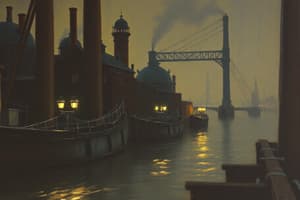Podcast
Questions and Answers
What is the Union Pacific Railroad?
What is the Union Pacific Railroad?
- A railroad that started in Sacramento
- A railroad that started in Omaha (correct)
- A railroad that only operated in California
- A railroad that only connected with the Great Northern Railroad
What was Credit Mobilier involved in?
What was Credit Mobilier involved in?
- Building the Union Pacific Railroad (correct)
- Operating the Central Pacific Railroad
- Establishing the Interstate Commerce Commission
- None of the above
What was the Central Pacific Railroad?
What was the Central Pacific Railroad?
A railroad that started in Sacramento and connected with the Union Pacific Railroad in Promontory Point, Utah.
Who were the Big Four?
Who were the Big Four?
What was the Transcontinental Line?
What was the Transcontinental Line?
What is the significance of the Northern Pacific Railroad?
What is the significance of the Northern Pacific Railroad?
What role did the Atchison, Topeka, and Santa Fe Railroad play?
What role did the Atchison, Topeka, and Santa Fe Railroad play?
What was the Great Northern Railroad known for?
What was the Great Northern Railroad known for?
Who was James J. Hill?
Who was James J. Hill?
What did the term 'pool arrangements' refer to?
What did the term 'pool arrangements' refer to?
The Interstate Commerce Act was established to regulate railroad prices.
The Interstate Commerce Act was established to regulate railroad prices.
What did the Sherman Anti-Trust Act aim to do?
What did the Sherman Anti-Trust Act aim to do?
What is the Gospel of Wealth?
What is the Gospel of Wealth?
Who is known for the Bessemer process?
Who is known for the Bessemer process?
What was the significance of the American Federation of Labor?
What was the significance of the American Federation of Labor?
Who was Samuel Gompers?
Who was Samuel Gompers?
What was the purpose of 'yellow-dog contracts'?
What was the purpose of 'yellow-dog contracts'?
Study Notes
Railroads and Their Impact
- Union Pacific Railroad: Connects Omaha to Promentory Point, Utah, forming part of the First Transcontinental Railroad.
- Central Pacific Railroad: Begins in Sacramento and connects with Union Pacific at Promentory Point, Utah.
- Transcontinental Line: The railroad spanning from the Atlantic Ocean to the Pacific Ocean, facilitating cross-country transportation.
- Northern Pacific Railroad: Established a route running from Lake Superior to Puget Sound.
- Atchison, Topeka, and Santa Fe Railroad: Linked the Southwest deserts to California.
- Southern Pacific Railroad: Advanced interest in Southern California, changing perceptions of its agricultural viability.
- Great Northern Railroad: The northernmost transcontinental route, privately funded, connecting the West with the East.
Key Figures in Railroad Development
- The Big Four: Key entrepreneurs of the Central Pacific Railroad, included Leland Stanford, Collis P. Huntington, Mark Hopkins, and Charles Crocker.
- James J. Hill: Known as the "Empire Builder," he was instrumental in developing the Great Northern Railway.
- Commodore Cornelius Vanderbilt: Significant force behind the New York Central Railroad System.
Business Practices and Economic Structures
- Credit Mobilier: A company involved in building the Union Pacific, embroiled in a major bribery scandal in 1872.
- Stock Watering: A tactic used by railroad promoters to inflate stock prices misleadingly.
- Pool Arrangements: Informal agreements among companies to maintain high prices and limit competition, later restricted by the Interstate Commerce Act.
- Interstate Commerce Act: Established the ICC to oversee the regulation of railroad industries and prevent unfair pricing strategies.
Industrial Innovations and Impact
- Alexander Graham Bell: Inventor of the telephone, enhancing communication across distances.
- Thomas A. Edison: Prolific inventor credited with numerous innovations including the light bulb and phonograph.
- Bessemer Process: A method for steel production that revolutionized the manufacturing industry.
Rise of Major Industrialists
- Andrew Carnegie: Industrialist known for revolutionizing the steel industry and endorsing philanthropy through the Gospel of Wealth.
- John D. Rockefeller: Founder of Standard Oil, dramatically reshaped the petroleum industry.
- J.P. Morgan: Major banker who consolidated industries and financed significant ventures, including U.S. Steel.
Labor Movements and Union Dynamics
- National Labor Union: Formed in 1866, advocated for workers' rights including an eight-hour workday.
- Knights of Labor: A significant labor organization promoting social reforms, skilled and unskilled labor equality, and better conditions.
- American Federation of Labor (AFL): Established to unify labor unions, spearheaded by Samuel Gompers.
- Haymarket Square Incident: A pivotal event leading to the decline of the Knights of Labor, involving a bomb explosion during a labor protest.
Social Issues and Economic Philosophy
- Gospel of Wealth: Carnegie's concept emphasizing the wealthy's obligation to philanthropy, countering Social Darwinism.
- Social Darwinism: The misapplication of evolutionary theory to society, justifying economic disparity and imperialism.
- Sherman Anti-Trust Act: 1890 legislation aimed at curbing monopolies and promoting fair competition.
Challenges to Labor Rights
- Labor Conflicts: Actions such as "scabs" used to break strikes, "lockouts" enacted by employers, and "yellow-dog contracts" limiting union participation.
- "Mother" Jones: Labor activist who championed workers' rights and improved labor conditions, particularly for coal miners.
These notes highlight the critical developments, figures, and social changes during the Industrial Age in America from 1865 to 1900, focusing on the impact of railroads, significant industrialists, labor movements, and social philosophies.
Studying That Suits You
Use AI to generate personalized quizzes and flashcards to suit your learning preferences.
Description
Test your knowledge on Chapter 24 of 'The American Pageant' covering the Industrial Age from 1865 to 1900. This flashcard quiz includes key terms such as the Union Pacific Railroad and the Credit Mobilier scandal. Perfect for APUSH review!




